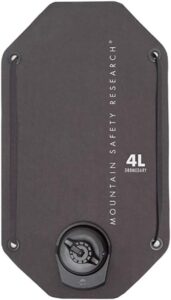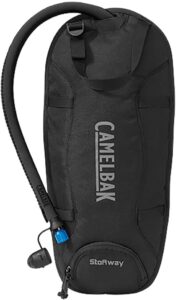8 Best Hydration Bladders for Hiking and Backpacking
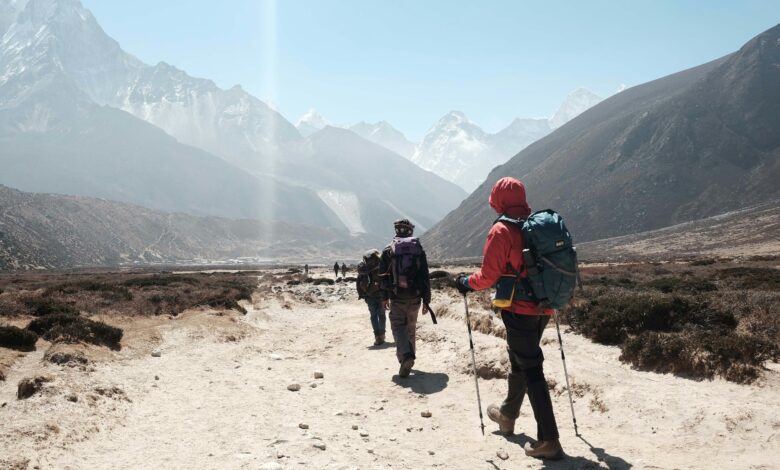
Staying hydrated on the trail is one of the most basic needs for any outdoor adventure. Whether you’re heading out for a day hike or going on a multi-day backpacking trip, having quick and convenient access to water can make or break your experience.
That’s where hydration bladders come in — these flexible reservoirs slot into your pack and let you sip water through a tube without stopping to pull out a bottle.
With there being so many options available, finding the right water bladder for your needs can be overwhelming. I’ve put together this water bladder review of the best hydration bladders, based on my field testing across many different terrains and conditions.
How We Tested
I didn’t just read about these hydration bladders, but I took them out on the trails, stuffed them into my backpacks, and used them in real-world conditions. I’ve evaluated each bladder based on ease of use, durability, leak resistance, taste, ease of cleaning, and the overall value.
My testing process involved filling and emptying each bladder multiple times, checking for leaks at connection points, evaluating how easy they were to clean, and assessing how they held up after repeated use. I tested them in hot weather to check for plastic taste issues and in freezing conditions to test insulation claims.
I also looked at packability, weight, and how easy they were to fill from different water sources — from kitchen sinks to shallow streams. While testing in varied weather conditions, I found that wearing the right hiking gear, like moisture-wicking hiking pants and layered tops, allowed me to adjust to temperature changes while keeping the hydration bladders accessible in my pack.
So after months of testing, I’ve identified the top performers that deserve a spot in your pack.
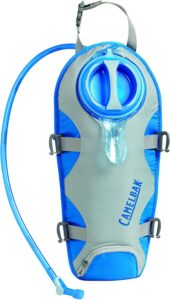
1. CamelBak Unbottle
Best Overall Hydration Bladder
The CamelBak UnBottle earned my top spot by excelling in pretty much every category I tested. Available in 2L and 3L capacities, this hydration solution combines CamelBak’s quality construction with thoughtful design features that make it stand out from the competition.
It has a clever design that allows you to add hydration to almost any situation, and the system consists of an outer insulating sleeve with four clip-on strap holders, a top clip-on loop, and a bottom strap. This lets you attach it to a backpack, strap it to a bike frame, or secure it to virtually any gear with straps.
During my testing, I found the UnBottle to be leak-proof, which can be hard to find. The screw-top opening creates a secure seal, and the connection between the bladder and hose remained watertight even when jostled around on rough trails.
The bite valve delivers a good flow rate without unwanted dripping, and the shut-off valve prevents accidental discharge when you’re not using it. The detachable drinking tube with CamelBak’s standard bite valve gives consistent water flow without much effort.
I appreciated how easily the tube detaches from the bladder, making refills and cleaning simpler than many competitors. The only downsides I found were that removing the tube from the bladder can be difficult, and taking the bladder out of its sleeve requires a bit of effort. That said, these minor inconveniences are far outweighed by the positives.
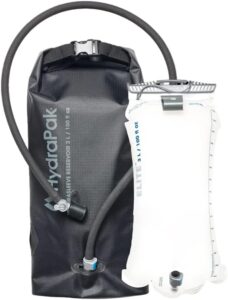
2. Hydrapak HydraSleeve
Best Hydration Bladder for Hiking
The Hydrapak HydraSleeve stands out as the best water bladder for hiking thanks to its awesome insulation properties and durable construction. This system includes both an insulated bladder sleeve and an insulated drinking tube, making it perfect for hikes in extreme weather conditions.
During my hot weather tests, the HydraSleeve kept water cold for an impressive six hours — about three times longer than standard bladders. I loaded it with ice-cold water and hiked for six hours in 85-90°F temperatures, finding ice cubes that did not melt at the end of the day.
You can use the bladder with or without the insulative sleeve depending on conditions, giving you flexibility based on your needs. The high-flow bite valve gives you an excellent rate of water flow, and I found the twist lock mechanism effective at preventing leaks.
The HydraSleeve also proved to be the most durable option I tested, as the nylon sleeve provides excellent protection against abrasion and punctures, and the bladder inside remained pristine even after being stuffed into overpacked backpacks.
At 12 ounces (including the sleeve), it’s heavier than non-insulated options, and it’s also the most expensive bladder I tested. But if you like to hike in extreme temperatures or if you just prefer the cold all day long, the HydraSleeve is well worth the investment.
3. MSR Dromedary Bag
Best Water Bladder for Backpacking
For multi-day backpacking trips where you need to be resourceful, the MSR Dromedary Bag is my top choice. These water carriers have earned a reputation for bombproof construction that can handle the difficulties that come with extended backcountry travel.
The Dromedary’s 1000-denier fabric exterior makes it nearly indestructible — I’ve strapped it to the outside of packs, dropped it on rocks, and subjected it to all kinds of abuse without a single puncture or leak.
The bag has a convenient handle for you to carry and fill it, plus a hang loop that’s perfect for setting up a camp kitchen or shower. I’ve even used the Dromedary to feed water into my camping kettle by holding it at just the right height—something that’s much harder to do with traditional bladders.
Beyond just storing drinking water, it can serve as a washing station, shower, hot water bottle, or food prep area. The 3-in-1 cap system allows you to either drink directly, pour water, or attach accessories.
In my tests, the Dromedary proved to be reliable on extended trips, with no leakage issues even after repeated use. The thick material also helps insulate the water, keeping it cooler than thinner bladders in hot weather.
At 17 ounces for the 10L version, it’s not the lightest option, but the durability-to-weight ratio is excellent for serious backcountry trips, and it’s especially valuable in areas where water sources are scarce and large carrying capacity is needed.
4. CamelBak Stoaway Hydration Bladder Reservoir
Best Insulated Hydration Bladder
The CamelBak Stoaway is essentially the Crux reservoir, which is an upgraded version of the Antidote, with the addition of an insulated sleeve for both the bladder and hose, making it my top pick for insulated performance in cold or hot weather.
During winter testing, the Stoaway’s insulated hose stayed unfrozen for significantly longer than standard tubes, making it ideal for skiing, snowshoeing, or cold-weather hiking. In summer conditions, I found it kept water noticeably cooler throughout the day compared to non-insulated options.
The Crux reservoir design provides an excellent flow rate — 20% more water per sip than previous CamelBak models, and the ergonomic handle makes filling and handling the bladder easy, even when it’s full. I especially appreciated the large opening, which makes both filling and cleaning easier.
Like other CamelBak products, the bite valve delivers a good flow with minimal effort, and the on/off lever prevents leaks when not in use. The quick-release tube makes removing the bladder for refilling simple, even when packed into a tight hydration sleeve.
While this is one of the best water reservoirs, there is still a downside. The dark blue plastic makes it hard to spot mold growth inside the bladder, and the screw-top can be tough to open and close, especially when it’s cold. I’ve had to use a decent amount of force to loosen the lid after a winter hike.
That said, the insulation performance makes this a top choice for anyone who regularly adventures in extreme temperatures.
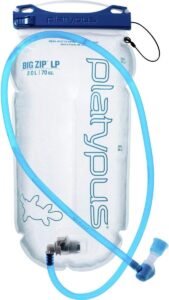
5. Platypus Hoser
Best Budget Hydration Bladder
At about half the price of premium models, the Platypus Hoser is reliable and comes in a simple, lightweight package, making it my top budget pick. Available in 1L, 1.5L, and 3L sizes, this bladder doesn’t compromise on the essentials.
What impressed me most during testing was the Hoser’s incredible packability. When empty, it rolls up smaller than any other bladder I’ve tested — about the size of a small energy bar — making it perfect for ultralight backpacking or as a backup water carrier. At just 4.2 ounces for the 3L version, it’s also one of the lightest options available.
The Hoser features a simple design with Platypus’s HyFLO bite valve that gives a surprisingly good flow rate, and the taste is clean and doesn’t have the plastic flavor that plagues some cheaper bladders, even when water was left inside for several days.
The bladder’s material proved to be more durable than I expected, standing up to being stuffed into overpacked bags without leaking. The main drawback is the lack of a shutoff valve on the bite valve, which led to occasional drips when the bladder was compressed in my pack — I’ve ended up with a damp spot on my back more than once.
I also found it more challenging to clean thoroughly due to the small opening. But for the price, these are acceptable compromises for many hikers.
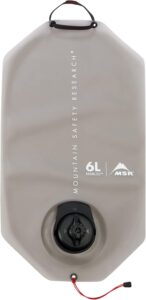
6. MSR DromLite Bag Water Reservoir
Best Lightweight Water Bladder
If you need a water bladder that’s super light, the MSR DromLite Bag is my top recommendation. It strikes an impressive balance between weight, durability, and functionality that’s hard to beat.
At just 5.2 ounces for the 4L version, the DromLite is surprisingly lightweight for its capacity. When empty, it collapses down to the size of its lid, taking up little space in your pack, which makes it perfect for trips where weight and space are at a premium.
Unlike the Dromedary, the DromLite uses a 200-denier Cordura fabric with food-grade polyurethane coating. This proved plenty durable for backcountry use — I’ve dropped it, dragged it, and stuffed it without issues. The material is puncture-resistant while remaining flexible enough to compress when it’s partially empty.
The 3-in-1 cap allows for easy drinking, pouring, or attaching accessories, and if you want to use it as a hydration system, MSR sells a separate hydration kit that transforms the DromLite into a full bladder with a drinking tube.
I found the wide profile prevented it from fitting into some narrower hydration sleeves, and long-term testing revealed that the lid can develop leaks after extensive use — mine started to drip slightly after about two years of regular use. That said, for lightweight trips where versatility is key, the DromLite remains my go-to option.
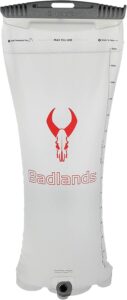
7. Badlands Hydration Reservoir
The Badlands Hydration Reservoir caught my attention with its design features that particularly benefit hunters and tactical pack users. As one of the best hydration reservoirs, this 3L bladder comes with an insulated tube that prevents freezing in cold conditions and helps keep water cool in hot weather.
In my freezing tests, the Badlands’ insulated tube remained unfrozen for about 30 minutes in freezer conditions — 10 minutes longer than uninsulated tubes but not quite as long as the HydraSleeve. The insulation made a noticeable difference during early morning hunts and cold-weather outings.
The bladder features a quick-disconnect fitting that allows you to remove it from your pack without rerouting the hose, which I found extremely convenient when refilling. The bite valve gives a decent flow rate, and the twist-lock mechanism effectively prevents leaks, but it does require two hands to operate.
I appreciated how easily the Badlands reservoir could be flipped inside out for cleaning and drying. As a bonus, it’s dishwasher-safe (top rack only), making maintenance simpler than many other models.
The bladder material has a slightly tacky surface that can make it tough to slide into tight hydration pockets — I had to wrestle it into my daypack more than once. But the overall construction quality is excellent.
For hunters or tactical users who need reliable hydration in varying conditions, the Badlands Reservoir is a solid choice.
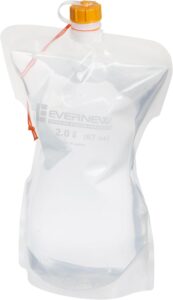
8. Evernew Water Carry System
The Evernew Water Carry reservoir earned a spot on my list because it’s great at something very specific — serving as part of a gravity water filtration system. The 2L version I tested has become my go-to for backcountry water treatment.
Because of its thread compatibility with Sawyer filters and similar products, it’s well suited for filtration. I found this integration much more reliable than using the often-flimsy bags that come with most filter systems, and Evernew’s construction proved far more durable than standard filter bags.
The water reservoir in this pick for the best hydration bladder features a gusseted bottom that allows it to stand upright when you fill it, which is incredibly convenient for filling and filtering. The attached cap eliminates the risk of dropping or losing it — a small detail I’ve come to appreciate after fumbling with loose caps in the field.
When tent camping, I’ve found hanging the Evernew from a nearby tree branch overnight helps settle any sediment to the bottom while keeping it elevated away from curious wildlife, just one of many tent site organization tactics that make woods living more comfortable.
At just 1.5 ounces, it’s pretty lightweight while still being tough enough for regular use. My long-term testing showed no issues with microbial growth even after months of continuous use, and there was no plastic taste in the water.
The only significant issue I found was that the cap tends to leak unless you tighten it very firmly — I’ve had to use considerable force to prevent drips. Despite this minor issue, for backpackers who use gravity filters, the Evernew Water Carry System offers an elegant solution that’s both lightweight and durable.
How to Choose the Best Hydration Bladder
Finding the right water bladder for your needs means that you need to consider several factors other than just capacity. Here’s what you need to know before making your decision:
Capacity
Most hydration bladders come in sizes ranging from 1 to 3 liters, with some larger options available. For day hikes in moderate conditions, a 2L bladder is typically fine.
For long days in hot weather or multi-day trips where refill options are limited, consider a 3L capacity. Remember that water weighs about 2.2 pounds per liter, so balance your hydration needs with weight considerations.
Opening and Closure Type
Hydration bladders generally use one of two opening styles, screw-top or slide-top (sometimes called zip-top).
Screw-top openings, like those on the CamelBak models, offer a reliable seal but can be harder to thoroughly clean due to the smaller opening. They’re typically more leak-proof over time but can be difficult to operate with cold hands.
Slide-top openings, found on bladders like the Platypus Big Zip, provide full-width access to the bladder interior, making cleaning much easier. They can sometimes be trickier to close properly, especially in cold conditions, but generally offer good leak protection when you seal them correctly.
Insulated vs Non-Insulated Water Bladder
Insulation becomes important in extreme temperatures. In cold conditions, an insulated tube prevents your water from freezing mid-hike. In hot weather, insulation keeps your water cooler for longer periods.
The HydraPak HydraSleeve and CamelBak Stoaway have excellent insulation for both the tube and bladder, keeping water from freezing up to twice as long as non-insulated systems in my tests. They also kept cold water cool for about three times longer than standard bladders in hot conditions.
For most three-season hiking in moderate climates, a non-insulated bladder is perfectly adequate and saves weight. But if you regularly hike in freezing conditions or very hot weather, the extra ounces for insulation are well worth it.
Bite Valve and Flow Rate
The bite valve is your interface with the hydration system, so it’s worth carefully considering. Look for valves that provide adequate flow with minimal effort but don’t leak when not in use.
I’ve found that the Platypus Big Zip Evo and Gregory 3D Hydro delivered the fastest flow rates, while the CamelBak valves offered a good balance of flow and leak prevention. Many bladders also have a locking mechanism on the bite valve, which prevents accidental leakage when the bladder is compressed in your pack.
Quick-Release Connection
A quick-release connection between the hose and reservoir makes refilling much easier, and you can leave the hose routed through your pack while removing just the bladder for refills. I’ve found this feature especially helpful on multi-day trips where I’m refilling frequently.
Durability and Weight
For maximum durability, look to thicker materials like those used in the MSR Dromedary or the protective sleeve of the HydraPak HydraSleeve, as these options will withstand more abuse but come with a weight penalty.
For ultralight applications where every ounce matters, the Platypus Hoser and MSR DromLite have excellent weight-to-durability ratios. Just be more mindful of how you pack and handle these lighter bladders.
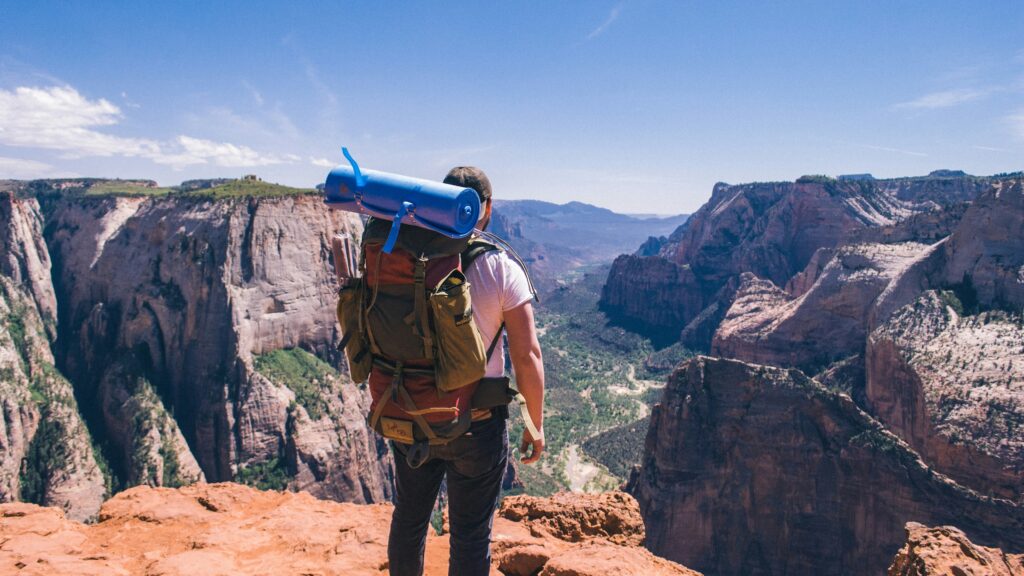
Best Way to Clean a Hydration Bladder
Proper cleaning is essential to prevent mold and bacteria growth in your hydration system. Here’s my recommended cleaning routine based on years of field testing:
- Rinse after every use with clean water, even if you only used water in your bladder.
- For a deep clean, use a mild dish soap or specialized cleaning tablets designed for hydration systems.
- For bladders that can be flipped inside out (like the HydraPak models), turn them inside out and wash them with warm soapy water.
- Use a bottle brush to scrub the interior of bladders that can’t be inverted.
- Don’t forget to clean the tube and bite valve — run soapy water through the entire system or use a specialized cleaning kit with a tube brush.
- After cleaning, hang the bladder upside down to dry completely. Use a prop (like kitchen tongs) to keep the opening spread for better airflow.
- Store your clean, dry bladder in the freezer between uses — this prevents mold growth during storage.
- For stubborn tastes or odors, try a solution of baking soda and water or denture cleaning tablets.
Bladders with wide openings, like the Platypus Big Zip Evo or HydraPak Shape-Shift, are generally easier to clean than those with smaller openings like the Platypus Hoser.
Reservoir Maintenance Tips
Keeping your hydration bladder in top condition doesn’t need to be complicated, but it does require some regular attention. Through years of using these systems, I’ve come up with a few simple maintenance habits that can make them last longer.
For CamelBak models like the UnBottle and Stoaway, the dark blue material makes spotting mold difficult. I make it a point to rinse these thoroughly after each use and dry them with the opening fully extended. The large opening on the Stoaway makes this easier, but I’ve found using a clean dish towel to wipe the interior helps remove any remaining moisture.
The Platypus Hoser’s small opening makes cleaning difficult. I use a cleaning tablet dissolved in warm water and shake it to reach all interior surfaces. After rinsing, blow a small amount of air into the bladder, as it helps inflate it enough to dry properly. Without this trick, the sides tend to stick together, trapping moisture.
For bladders with detachable hoses like the HydraPak HydraSleeve and Badlands Hydration Reservoir, I always disconnect and clean the components separately.
The quick-disconnect fittings need occasional lubrication with food-grade silicone to prevent them from sticking. I learned this the hard way after a fitting on my HydraSleeve became impossible to disconnect after a season of neglecting it.
The MSR Dromedary and DromLite bags benefit from occasional deep cleaning with a solution of vinegar and water (about 1:5 ratio) to prevent any taste development. Their durable materials can handle a more thorough scrubbing than the thinner bladders in this lineup.
For bite valves across all models, I’ve found that removing them periodically and soaking them in a mild bleach solution (1 teaspoon per gallon of water) helps prevent mold growth in these hard-to-see areas. Just remember to rinse extremely thoroughly afterward.
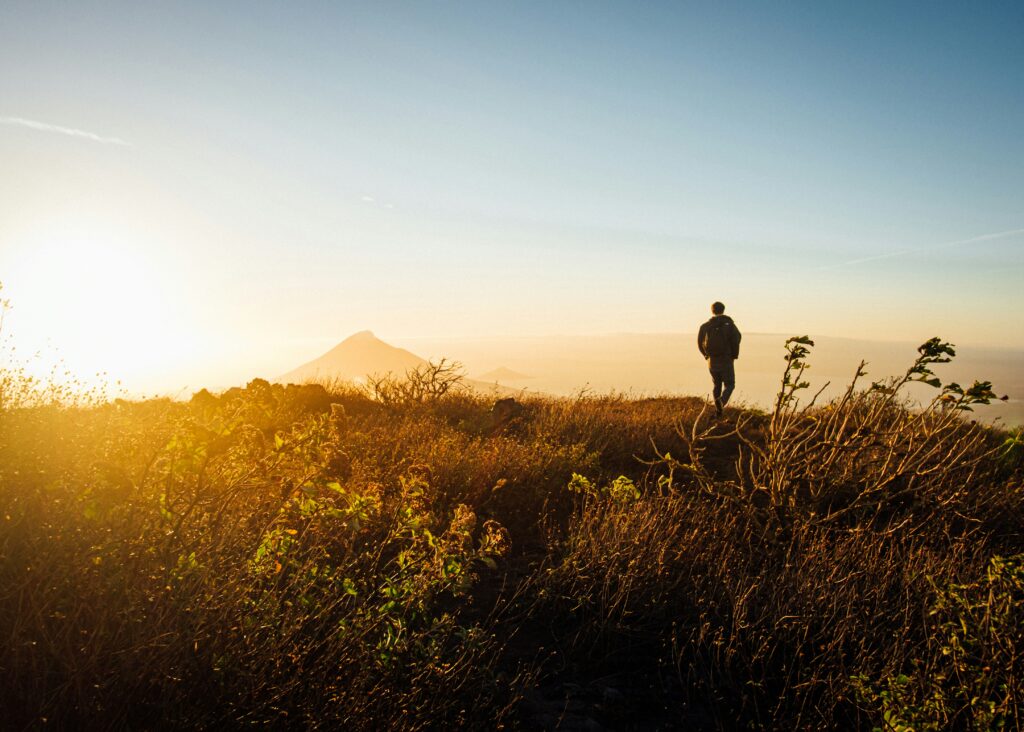
BONUS: Hydration Packs
When choosing a hydration bladder, try to keep in mind how well it will work with your existing backpack or whether you’ll need a dedicated hydration pack. I’ve tested a bunch of combinations of bladders and backpacks to identify what works best.
Not all hydration bladders fit perfectly in every pack’s hydration sleeve. The shape and size of the reservoir pocket can limit your options, and I’ve unfortunately discovered this the hard way after purchasing bladders that wouldn’t slide into specific packs.
Generally, slim-profile bladders like the Platypus Hoser and Big Zip Evo work well in most hydration sleeves, while wider models like the MSR DromLite might be too broad for narrower pockets.
Most modern hiking packs include designated ports and clips for hydration tubes, but their placement varies. I’ve found that bladders with longer tubes (like the CamelBak models) offer more flexibility for routing, while shorter tubes might not reach your shoulder strap in some configurations.
The CamelBak UnBottle’s attachment system makes it exceptionally adaptable to different pack styles. I’ve successfully used it with everything from daypacks to expedition packs, thanks to its four clip-on strap holders and bottom strap that can attach to virtually any point on a pack.
If you’re using a tactical or hunting pack, look for bladders with quick-disconnect fittings located high on the tube (like the Badlands model). These allow you to detach the reservoir without rerouting the entire hose through your pack — a feature I’ve come to appreciate during hunting trips when frequent refills are necessary.
For winter activities, the HydraPak HydraSleeve or CamelBak Stoaway are your best bets since they include insulated tube routing. I’ve had my water freeze solid during skiing outings when using non-insulated bladders, even when the reservoir itself was protected inside my pack.
Final Thoughts
After testing these best hydration bladders across various activities and conditions, two options stand out to me.
If you love to hike and be outdoors, the CamelBak UnBottle is the best for durability, ease of use, and versatility. Its reliable construction and design features make it an excellent all-around choice that will serve you well in most conditions.
If you frequently adventure in extreme temperatures or simply prefer your water cold all day long, the HydraPak HydraSleeve is worth the extra investment. Its superior insulation performance and modular design make it flexible for varying conditions, and its durability ensures it will last for many seasons of adventure.
Whichever hydration bladder you choose, having easy access to water while on the move will improve your outdoor experience and help you stay properly hydrated.

